Executive Summary
Financing WASH Services sustainably – in the sense of securing service delivery after implementation – has proven to be a challenge. Providing sustainable WASH services requires sound strategic financial planning to ensure that existing and prospective resources are appropriate for investment needs and costs of operating and maintaining services. Accounting for the capital maintenance, direct and indirect support costs in the life-cycle of services is often “forgotten” and the mechanisms and institutional changes catering for them left unaddressed (AGUASAN 2012). Hence, a planning tool, such as an indicator framework for financial sustainability of WASH services is needed. Different organisations have recently produced such frameworks (e.g. the life-cycle cost approach from WASHCOST), which provide an overview of important aspects for achieving financial sustainability. Life-cycle cost analysis, cost-benefit analysis and strategic finance planning are software tools that support the evaluation and allocation of SSWM project costs (IRC 2012; GWP 2008).
About Financial Sustainability
Considerable effort has been done towards scaling-up coverage of WASH services in recent years. Sustaining these services in the long-term is crucial. Supplying water as well as providing sanitation and hygiene services incur financial cost not only with regards to initial capital investments, but also during operation and maintenance, rehabilitation, upgrading and expansion phases. Financial sustainability focuses on how the governments, donors, civil society and private sector that are responsible for WASH services can ensure revenue streams to cover all costs (AGUASAN 2012).
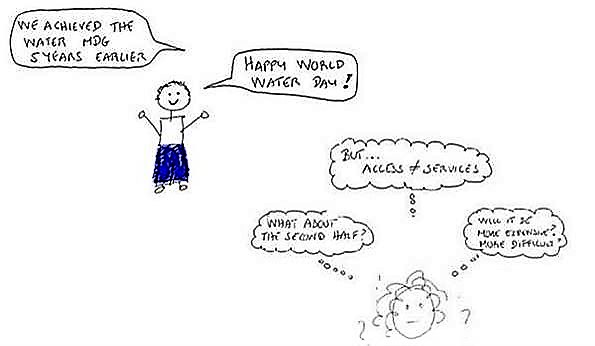
The most important aspect in financial sustainability is the planning process. With initial capital expenditure the service level raises. However if maintenance and service security is not planned in terms of costs and responsibilities, the service level drops in the long-run and leads to disappointment (IRC 2010). Therefore, cost and finance planning must be an integral part of ensuring sustainability, and the elements of the following Financial Sustainability Framework have to be considered for sustainable finance planning (AGUASAN 2012).
Financial Sustainability Framework
Adapted from AGUASAN (2012)
For sound finance planning the following aspects have to be considered and evaluated in advance:
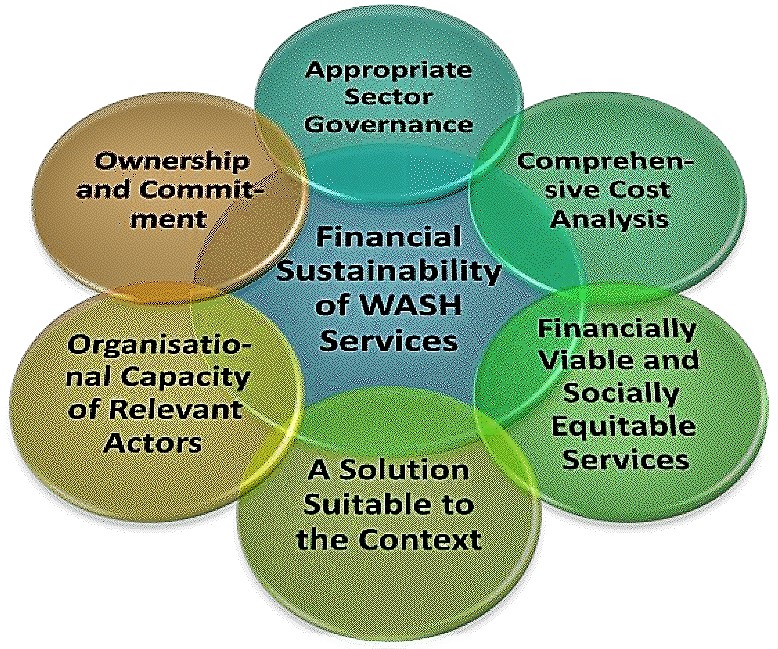
This framework has been elaborated by the 43 participants of the AGUASAN workshop 2012 (AGUASAN 2012) that are professionals in the field of planning for water supply and sanitation management as well as more generic development specialists. Throughout the continuous learning process, the workshop participants came up with six key elements for the financial sustainability of WASH services(see figure and table below).
| Key elements | Guiding questions | Tasks to improve financial sustainability |
| 1. Appropriate sector governance | How favourable is the legal framework? | - Clarify roles & responsibilities of various stakeholders - Ensure an independent regulatory body - Keep in mind, national governments are responsible for ensuring WASH services |
|
| How predictable is sector financing and planning? | - Ensure national mechanisms for planning and monitoring |
|
| Are mechanisms in place to ensure transparency and accountability? | - Consider monitoring & evaluation |
|
| Are mechanisms in place to ensure reflection and sector learning? | - Consider monitoring & evaluation |
| See also factsheet on: Policies and Legal Framework, Institutional Framework, Government Contributions, Water Pricing General, Public Private Partnerships in Water Purification, Donor Agencies and Using Indicators to Measure Progress. | ||
| 2. Comprehensive cost analysis | Are all costs identified, quantified and monitored at national or regional level? | - Include initial investment costs, maintenance, replacement and extension/upgrading of services |
|
| What are the costs at local level? | - Include often forgotten costs (water resource protection, risk mitigation, Operation & Maintenance (O&M)) |
| TOOLS | Life-cycle cost approach | |
| See also factsheet on: Budget Allocation and Resource Planning and Operation and Maintenance. | ||
| 3. Financially viable and socially equitable services | Are the revenues of taxes, tariffs and transfers greater than all life-cycle costs, and access to the poor ensured? |
|
|
| Are diversified and adaptable financing mechanisms in place to ensure human rights to WASH? |
|
| TOOLS | Business plan, human rights tool kit | |
| See also factsheet on: The Right to Water and Sanitation | ||
| 4. A solution suitable to the context | Is the solution appropriate and affordable? | - Check if technology is socially acceptable, financially affordable and environmentally suitable - Minimise administrative burden - Match O&M tasks to the local capacities of the system managers - Fit the service level to the users’ preferences |
|
| Is it adapted to specific institutional and organisational contexts (e.g. fragile states)? | - Carry out in-depth analysis of the situation - Provide capacity building - Carry out household-centred problem solving |
| See also the various factsheets on: Sanitation Frameworks and Approaches (category of the Programming and Planning Frameworks section) and Planning with the Community (category of the Decision Making section) | ||
| 5. Organisational capacity of relevant actors | Where are the capacity gaps? | Check if they are: - Administrative - Managerial - Technical - Financial - Analytical |
|
| Are financial skills enhanced (e.g. to secure financial reserves and manageaccumulated funds effectively)? |
|
| 6. Ownership and commitment | Is leadership committed? |
|
|
| Are all relevant stakeholders identified, actively involved, highly committed and effectively participating? |
|
|
| Are the economic benefits identified, understood and valued? | - Launch advocacy strategies at policy level - Carry out awareness raising at community level |
| TOOLS | Cost-benefit analysis | |
| See also factsheet on: Creating an Enabling Environment in Wastewater Treatment (see PDF) and Awareness Raising for Demand Creation | ||
How to Use the Framework?
Start by evaluating your existing system – drawing a table of current costs, responsibilities and financing gaps – and move on to a future version of an improved system. The steps of the framework serve a realistic assessment of your system and the identification of opportunities.
| Who pays for what? | Who will pay for what in 10 years? | ||
| National/ regional governments | Municipal governments | National/ regional governments | Municipal governments |
| Community | Households | Community | Households |
| Externals | Other | Externals | Other |
| Gaps? Unplanned costs? | Gaps? Unplanned costs? | ||
Allocating costs and financing gaps of WASH services. Source: AGUASAN (2012)
The life-cycle cost approach, cost-benefit analysis and strategic finance planning (SFP) described below will help you in evaluating all costs.
Subscribe here to the new Sanitation and Water Entrepreneurship Pact (SWEP) newsletter. SWEP is a network of organizations joining hands to help entrepreneurs design and develop lasting water and sanitation businesses.
What Are the Costs and Who Should Pay for Them?
Life-Cycle Cost Approach
Adapted from WASHCOST (2011); IRC (2011); FONSECA et al. (2011)
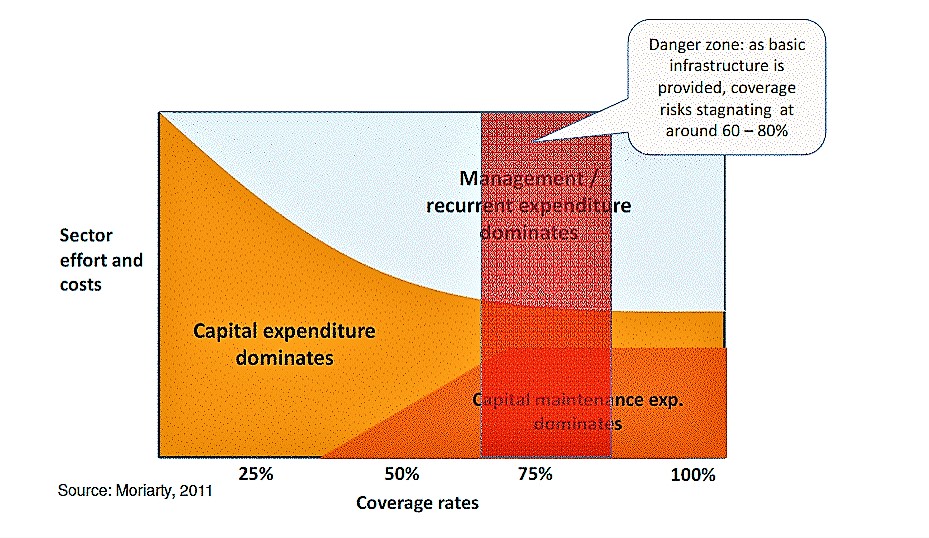
Which costs have to be considered for making WASH services last? The life-cycle cost approach is a methodology for monitoring and costing sustainable water, sanitation and hygiene (WASH) services by assessing costs and comparing them against levels of service provided. WASH services are expected to last. However, analysis in Africa and India has shown that there is little cost planning done in the service chain. This results in service levels dropping a certain time after project implementation. The life-cycle cost approach is based on the service delivery approach and aims at profound finance planning, taking into account all future costs (WASHCOST 2011; FONSECA et al. 2011).
When priority is given to capital expenditure only and recurrent costs get little attention in the cost planning, coverage rates stagnate at some point.Therefore the financial system has to ensure replacement of infrastructure when it is broken as well as extension of delivery systems when demand increases. Life-cycle means that costs follow a certain cycle and each cost component has to be considered in the planning – the costs that are needed to sustain, repair and replace a water (or sanitation) system throughout its cycle of wear, repair and renewal so it provides a service forever (IRC 2011).
Overview of Costs
Below you see an exhaustive overview of the costs to be considered to make water and sanitation solutions last, according to the life-cycle cost approach (adapted from IRC 2011).
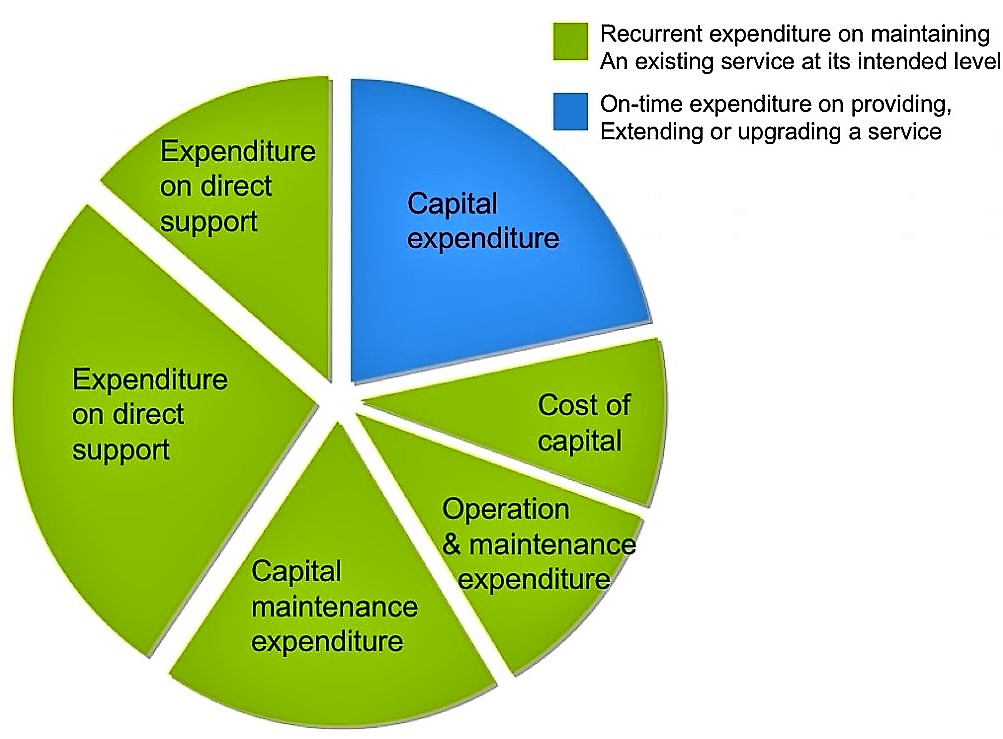
- Capital expenditure: Initial costs of putting new services into place: “hardware” such as pipes, toilets and pumps and one-off “software” such as training and consultations.
- Cost of capital:The cost of borrowing money or investing in the service instead of another investment opportunity. It also includes any profits made by the service providers not reinvested. It has a direct impact on the ability to maintain a service financially.
- Operation and maintenance expenditure:Routine maintenance and operation costs that are crucial to keep services running, e.g. wages, fuel, or any other regular purchases. Neglect has long-term consequences for service delivery, e.g. expensive capital (maintenance) expenditure and/or service failure.
- Capital maintenance expenditure:Occasional large maintenance costs for the renewal, replacement, and rehabilitation of a system. These essential expenditures are required before failure occurs to maintain a level of service and need to be planned in. This is one of the most frequently “forgotten” costs.
- Expenditure on direct support:Pre and post-construction support costs not directly related to implementation, e.g. training for community or private sector operators or user groups. These costs are often forgotten in rural water and sanitation estimates but are necessary to achieve long-term functionality and scale.
- Expenditure on indirect support:The costs of planning and policy making at governmental level and capacity building of professionals and technicians. These costs have a direct impact on long-term sustainability.
Planning and identifying life-cycle costs is an essential aspect of a ‘service delivery approach’ geared towards achieving sustainable services at scale (WASHCOST 2011). By understanding how the different cost components affect the overall costs, finance planning can counteract interruptions of service provision and avoid backslides to use of unsafe water sources and environmental risks through open defecation (IRC 2011).
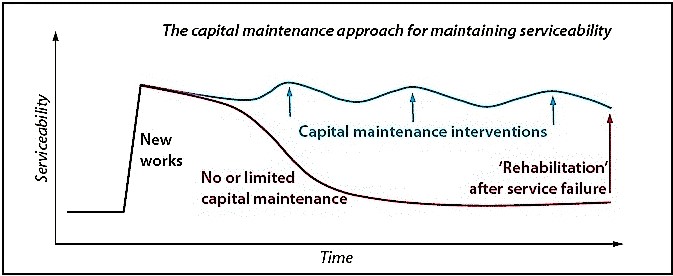
Valuing Costs and Benefits
Adapted from HUTTON (2012)
The objective of valuing costs and benefits is to understand their relation and compare them in monetary units, in order to utilise these operationalised benefits for better advocacy and decision-making.
What are benefits of improved water and sanitation?
- Health benefits:health care cost saving, health-related productivity, lower mortality-rates
- Environmental benefits:less water pollution, land use changes, energy/carbon/nutrients recovery
- Social and private benefits:more dignity, privacy, comfort, security, gender equality, better physical access
- Broader economic benefits:tourism revenues, business benefits, income generating water and sanitation markets
There are several methods how the benefit-cost analysis can be used as an economic tool for advocacy and decision-making:
- Benefit-cost ratio: evaluating the ratio by which benefits exceed costs comparing actual versus optimal conditions (on a time horizon of 20 years).
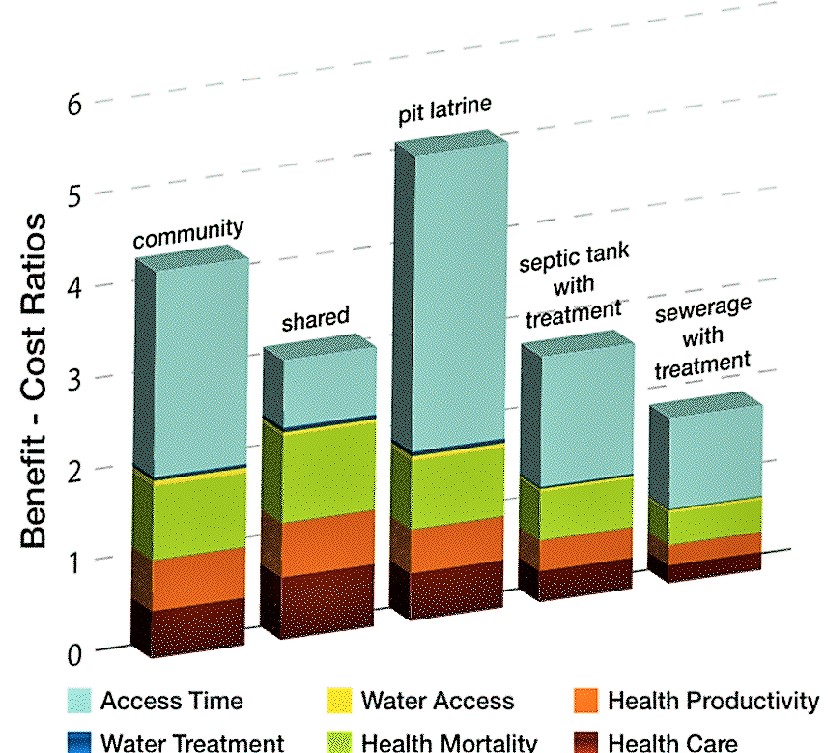
- Internal rate of return: annual rate of return on an investment.
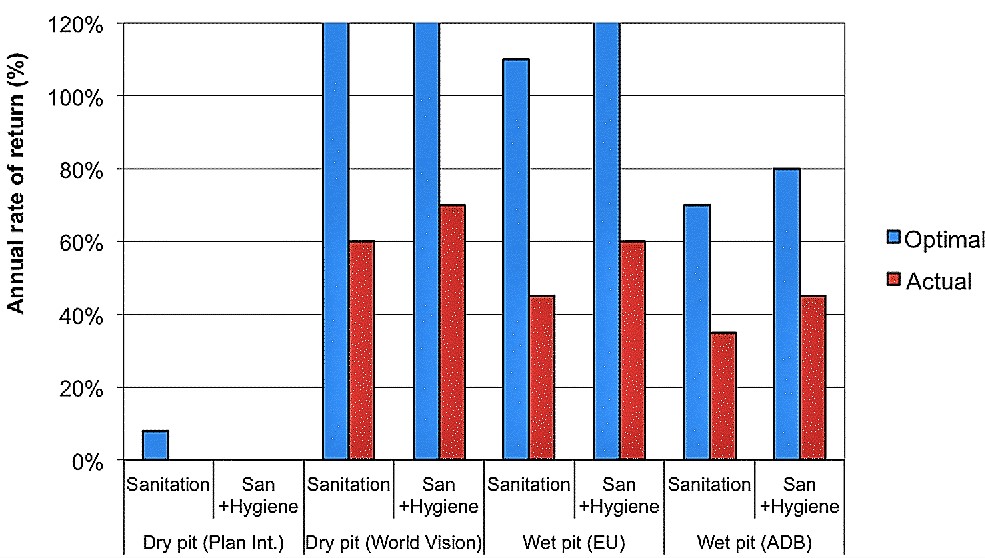
- Payback period: after how many years do net benefits become positive?
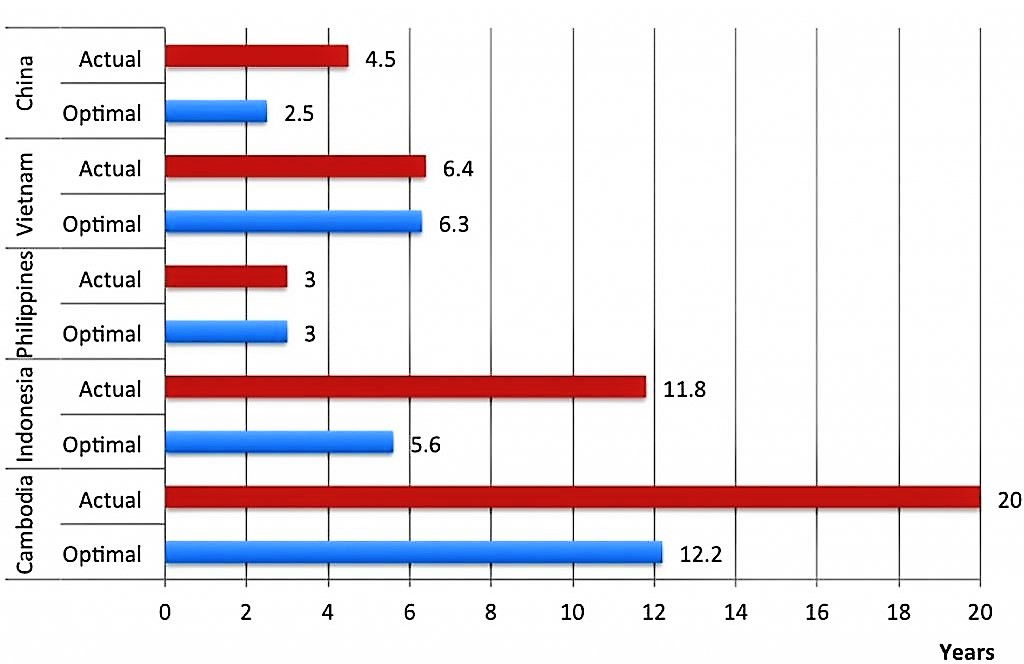
Strategic Financial Planning (SFP)
Adapted from GWP (2008) and OECD (2009)
SFP aims at making the financing of infrastructure and services more predictable. It combines planning and financing – which are typically done separately – to make spending ambitions more compatible with available financial resources. Equally, financing strategies can be tailored to what is actually needed, which improves the prospects of getting funding (GWP 2008).
The frameworks objectives are:
- To provide a structure for policy dialogue, involving all stakeholders.
- Illustrating long-term impacts of set targets.
- To link sector policies with projects.
- To enable external financing through transparent and clear finance planning (OECD 2009).
General elements of Strategic Finance Planning:
- Building scenarios (≥10-20 years) of investment and service planning for the sub-sector (e.g. water supply and sanitation, irrigation, wastewater), including estimated costs for capital investment and recurrent operation and maintenance.
- Projecting feasible sources of finance for both the initial capital investment and the recurrent costs of operating services.
Tariffs and other user charges, subsidies from the government, contributions from NGOs, loans, private equity, loans on concessional terms from international financing institutions (IFIs), other sources (use only project finance that is likely available) - When finance gaps appear, a process of iteration takes place, involving revisions to both the spending and financing scenarios. Spending plans are adjusted to make them more realistic (like: less ambitious targets, more cost-effective options, demand management programmes, more attenuated implementation periods), while more rigorous assumptions are made about financing sources (higher tariffs, greater engagement with donors and IFIs, use of financial engineering and innovative financing sources and more.
This iteration goes on for several rounds until the spending scenarios are compatible with feasible sources of finance (GWP 2008).
The presented frameworks and software tools are applicable at any planning level (for governmental planning as well as for local or community planning). They are to be applied in the planning phase of the project and are themselves a part of the planning process. The usage of these tools requires excellent knowledge of the existing SSWM systems and policies.
Briefing Note: Financial Sustainability of WASH Services – About Mindset Change and an Eye for the Future
Theme Paper: tracking Functionality of WASH facilities – A key to Sustainable Services. Annual Review Conference of the Community Water and Sanitation Agency
Life-cycle costs approach. Briefing Note 1a
Services are forever: The importance of capital maintenance (CapManEx) in ensuring sustainable WASH services. Briefing Note 1b
Strategic financial planning
Valuing Costs and Benefits
WASHCost’s theory of change: reforms in the water sector and what they mean for the use of unit costs. Working Paper 1
Introduction: From systems to services. Module 1
Costing sustainable services. Module 1
Life-cycle cost approach policy meeting
We can no more expect unmaintained pumps to provide services than we can a car with no fuel to take us on our journey
Strategic Financial Planning for Water Supply and Sanitation
Life-cycle cost approach
This brochure gives a brief and clear overview of the theory and usage of the life-cycle cost approach for financial planning, concerning water and sanitation services.
WASHCOST (2011): Life-cycle cost approach. The Hague: IRC International Water and Sanitation Centre URL [Accessed: 18.06.2019]The Economic Returns of Sanitation Interventions in Yunnan Province, People’s Republic of China
This is the Brief note on a multi-country study launched in 2007 as a response by the World Bank’s Water and Sanitation Program to address major gaps in evidence among developing countries on the economic aspects of sanitation. Its objective is to provide economic evidence to increase the volumes and efficiency of public and private spending on sanitation. The Brief note summarises key findings of Study Phase II—cost-benefit analysis of alternative sanitation options—from Yunnan Province.
WSP (2011): The Economic Returns of Sanitation Interventions in Yunnan Province, People’s Republic of China. Washington DC: Water and Sanitation Programme, Worldbank URL [Accessed: 18.06.2019]Financing Water: Investing in Sustainable Growth
This policy perspective summarises key messages about the economic case for water investment, the barriers to investment and the financing gap. It charts a course for action to better value water and to facilitate water investment at scale. The Roundtable on Water Financing, a joint initiative of the OECD, the World Water Council and the Netherlands, will continue to deepen the evidence base and broaden engagement on these issues.
Briefing Note: Financial Sustainability of WASH Services – About Mindset Change and an Eye for the Future
Developing Financing Strategies in Water Supply and Sanitation
This paper provides information about financing strategies in WSS that are realistic and meet established development objectives - and in doing this explain what is required to prepare them. Three questions are addressed: What is actually meant by a financing strategy in WSS? What are the stages of preparing, developing and implementing a financing strategy in WSS? And what are the major challenges when doing so?
EUWI (2007): Developing Financing Strategies in Water Supply and Sanitation. Kongens Lynby (Denmark): European Water Initiative (EUWI). [Accessed: 19.12.2012] PDFStrategic Financial Planning for water supply and sanitation in Africa
This paper explains the idea of Strategic Finance Planning, which is concerned with finding national consensus on future water and sanitation planning, including financial feasibility. The study focuses on water and sanitation services in Africa.
EUWI-FWG (2010): Strategic Financial Planning for water supply and sanitation in Africa. Stockholm: European Water Initiative Finance Working Group (EUWI-FWG) URL [Accessed: 18.06.2019]Financial and economic analysis - Factsheet of Working Group 2
This factsheet introduces financial and economic costs and benefits in relation to sanitation systems. It provides an overview of analytical approaches for comparing sanitation interventions using financial and economic analyses and illustrates these using results from various studies.
PARKINSON, J. HUTTON, G. PFEIFFER, V. BLUME, S. FEIEREISEN, P. (2012): Financial and economic analysis - Factsheet of Working Group 2. Eschborn: Sustainable Sanitation Alliance URL [Accessed: 18.06.2019]Life-cycle cost approach
This brochure gives a brief and clear overview of the theory and usage of the life-cycle cost approach for financial planning, concerning water and sanitation services.
WASHCOST (2011): Life-cycle cost approach. The Hague: IRC International Water and Sanitation Centre URL [Accessed: 18.06.2019]Financing Water and Sanitation for the Poor: six key solutions
Water and sanitation services for the very poor remain grossly deficient over large areas of the globe, and financing water and sanitation improvements for these people remains a major challenge. This paper proposes six key solutions to overcome this challenge.
WSUP (2012): Financing Water and Sanitation for the Poor: six key solutions. London: Water and Sanitation for the Urban Poor (WSUP) URL [Accessed: 18.06.2019]100 percent Access by Design
This Practice Note from WSUP (Water and Sanitation for the Urban Poor) describes an Excel-based financial analysis tool which generates reliable costings of different options for achieving 100% sanitation access across low-income and non-low-income areas.
WSUP (2013): 100 percent Access by Design . A Financial Tool for Urban Sanitation. (= Practice Note, PN#009, MAY 2013 ). London: Water and Sanitation for the Urban Poor (WSUP) URL [Accessed: 18.06.2019]Applying the Life-Cycle Costs Approach to Sanitation
This briefing note presents an application of the life-cycle costs approach (LCCA) to sanitation in rural and peri-urban areas in four different countries— Andhra Pradesh (India), Burkina Faso, Ghana, and Mozambique. The document compares the differences between the financial costs of traditional and improved latrines, and the quality of service delivered to users.
IRC (2011): Applying the Life-Cycle Costs Approach to Sanitation. (= Briefing Note , 3 ). The Hague: International Water and Sanitation Center (IRC) URL [Accessed: 18.06.2019]Mapping Sustainability Assessment Tools to Support Sustainable Water and Sanitation Service Delivery
This paper reviews five different sustainability assessment tools that are currently in use for programme monitoring of WASH interventions. The selected tools all have a developed framework that has each been pilot tested and produces an objective and quantifiable output (e.g., final score or percentage) that can be used to trigger improvements to programme design or take remedial actions.
BOULENOUAR, J. SCHWEITZER, R. LOCKWOOD, H. (2013): Mapping Sustainability Assessment Tools to Support Sustainable Water and Sanitation Service Delivery. (= Working Paper , 6 ). The Hague: International Water and Sanitation Centre (IRC), Water Services that Last URL [Accessed: 18.06.2019]Achieving Sustainability: Changing the Ways in Which we Define Success
Implementing agencies like WSUP, Water For People and IRC are of course accountable to their funders, including major bilaterals and foundations. And naturally, these funders must track the effectiveness of their spending. But short budget cycles and the need to demonstrate “value for money” can often encourage over-simplistic measurement of success in terms of short-term outputs, rather than genuinely sustainable services. This note proposes some ways forward.
COWLING, R. NORMAN, G. (2013): Achieving Sustainability: Changing the Ways in Which we Define Success. (= Perspective , 1 ). London: Water and Sanitation for the Urban Poor (WSUP) URL [Accessed: 25.11.2013]Study for Financial and Economic Analysis of Ecological Sanitation in Sub-Saharan Africa
This study focuses on the comparison of ecosan with conventional sanitation systems suitable for urban settlements in Sub-Saharan Africa. The aim of the study was to compare ecosan with conventional sanitation systems in terms of financial and economic costs and benefits, in order to assist decision-makers and sponsors of development programs to make informed decisions about relative merits of different types of sanitation. Based on two case study analysis, none of the currently implemented systems are seen to provide an obvious model for scaling up without considerable external support.
WSP (2009): Study for Financial and Economic Analysis of Ecological Sanitation in Sub-Saharan Africa. Washington: Water and Sanitation Program (WSP) URL [Accessed: 10.01.2011]The Economic Returns of Sanitation Interventions in Yunnan Province, People’s Republic of China
This is the Brief note on a multi-country study launched in 2007 as a response by the World Bank’s Water and Sanitation Program to address major gaps in evidence among developing countries on the economic aspects of sanitation. Its objective is to provide economic evidence to increase the volumes and efficiency of public and private spending on sanitation. The Brief note summarises key findings of Study Phase II—cost-benefit analysis of alternative sanitation options—from Yunnan Province.
WSP (2011): The Economic Returns of Sanitation Interventions in Yunnan Province, People’s Republic of China. Washington DC: Water and Sanitation Programme, Worldbank URL [Accessed: 18.06.2019]Get to Scale in Urban Sanitation!
Taking urban sanitation to scale requires ‘scaling out’ models that work for poorer communities, and at the same time ‘scaling up’ sustainable management processes. This short note reports scale-out and scale-up experience from Maputo and Antananarivo.
WSUP (2013): Get to Scale in Urban Sanitation!. (= Practice Note , 10 ). London: Water and Sanitation for the Urban Poor (WSUP) URL [Accessed: 22.04.2019]How Can INGOs Help Promote Sustainable Rural Water Services?
This paper examines how the international NGO WaterAid supports decentralised local governments in Mali to fulfil their role of service authorities within a service delivery approach for rural water services.
JONES, S. (2013): How Can INGOs Help Promote Sustainable Rural Water Services?. An Analysis of WaterAid’s Approach to Supporting Local Governments in Mali. In: Water Alternatives: Volume 6 , 350-366. URL [Accessed: 15.04.2019]The life-cycle cost approach to water, sanitation and hygiene. Module 1
The first module is an introduction to the life-cycle cost approach and the service delivery approach.
WASHCOST (2012): The life-cycle cost approach to water, sanitation and hygiene. Module 1. The Hague: IRC International Water and Sanitation Centre URL [Accessed: 18.06.2019]Implementing the life-cycle cost approach. Module 2
The second module is concerned with implications on how to implement the life-cycle cost approach in service planning, including data collection, check lists and methodological advice.
WASHCOST (2012): Implementing the life-cycle cost approach. Module 2. The Hague: IRC International Water and Sanitation Centre URL [Accessed: 18.06.2019]Analysing life-cycle costs and service levels. Module 3
The third and last module explains how to analyse the evaluated life-cycle costs and how to apply them to service levels.
WASHCOST (2012): Analysing life-cycle costs and service levels. Module 3. The Hague: IRC International Water and Sanitation Centre. [Accessed: 19.12.2012] PDFWASHCost Mozambique: How much does it cost to build a traditional latrine?
This video by IRC’s WASHCost project examines the full costs of building traditional latrines in Mozambique. There, cost data for planning are collected by local authorities. They gather the information around households in the area. Households are visited and their sanitation situation is assessed. This gives a clear picture of what is actually achieved.
WASH Sustainability Index Tool
The WASH Sustainability Index Tool, developed for the USAID-Rotary International H2O Collaboration, is a tool to assess sustainability of WASH programs. The tool considers the sustainability of institutional, management, financial, technical and environmental factors.

